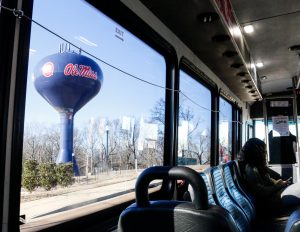For Yersaiyn Yerkin, a freshman international student studying mechanical engineering, the OUT bus is a lifeline. Thousands of miles away from his home country in Kazakhstan, Yerkin does not have a personal vehicle to get around Oxford. For essentials — getting to and from class, to the grocery store —Yerkin relies on the services of Oxford-University Transit.

“I think mostly I ride the bus to go to Walmart. I’m an international student, so I don’t have a car,” he said. “I usually go to Walmart on Saturday. Usually, the blue east will come every 30 minutes.”
Aniston McClellan is a senior pursuing a bachelor’s in multidisciplinary studies. She has a car but doesn’t use it to get to and from campus. Unable to secure a commuter parking pass and wary of the environmental cost of driving herself back and forth daily, McClellan started taking the bus and never looked back.
“Just this semester, I decided, well, actually, I didn’t decide. I kind of had to ride the bus when they ran out of commuter passes,” she said. “And then I realized that I liked riding the bus better. I felt like it was better for the environment and just didn’t have to pay the commuter pass.”
These two students are just a slice of the students, faculty, staff and Oxford citizens who use Oxford’s public bus system. Before the onset of the COVID-19 pandemic, OUT served as many as 1.4 million riders in the city of Oxford in a year. Since the pandemic, the charge for non-students and faculty was eliminated, making the service free for everyone. Beginning operation in 2008, the system has grown tremendously over the course of a decade and into this year.
For the 2021-2022 year, OUT’s combined budget was $5,253,662. Operating a fleet of 34 buses — some of which operate from early in the morning to 10 p.m. — along 19 routes, the system is incredibly sophisticated. According to OUT General Manager Donna Zampella, the main goal of OUT is to provide these riders with the best service possible.
The system is uniquely situated — most bus systems operate in cities that are significantly larger than that of Oxford. This comes with both rewards and challenges. The largest flaw in the system — according to both riders and management — is finding your bus.
“Sometimes they can have delays in their time of being here. Sometimes you can time them. And they’ll be there around that time,” graduate student Angela Stevens said. “And then other times, maybe they have a delay or maybe I miss this bus. Maybe the bus came through and you weren’t there. So you have to wait 20 minutes for the next one.”
McClellan describes her experience with the OUT bus system as overwhelmingly positive, despite the occasional inconveniences.
“Every once in a while if you’re in a rush or anything like that, it’s kind of inconvenient,” she said. “But for the most part, I’ve had a pretty positive experience with it.”
As simple as it may seem, getting information about the location of buses to riders is a rather complex task, and something OUT has been trying to get right since the system’s inception.
Initially, riders were given information based on a schedule through a company called NextBus. However, determining location based on a schedule is inherently flawed: if your bus was scheduled to arrive at 10:30, this system would tell you your bus was there even if it wasn’t, failing to account for things like traffic and other delays.
OUT then joined other Mississippi Department of Transportation providers in moving to a system that had been in place until recently. This system, QRide, used live tracking, however, it could only be accessed via a web page — and in 2022, no one really wants to go to a webpage to find anything. Additionally, OUT’s fixed route system is relatively complex. When they realized QRide wasn’t working either, OUT management began to look elsewhere.
At the time of the interview in late February, Zampella shared with The Daily Mississippian that OUT was in the process of negotiating contracts with TransLoc.
In addition to an app interface, TransLoc will provide improved live tracking and an overall simpler user experience: if you are at Walmart and need to get to the union, the app will tell you exactly which buses to take and when they are arriving. Users also have the option to receive a notice when their bus is approaching. Zampella is hoping to have this new system in place by fall 2022.
“So, that’s a grand thing. We’re hoping now that works the way we want it to work. It’s technology, you know? Not everything is 100%,” she said. “But know that we are not out of touch with what’s going on in the city and the university.”
While OUT seems to be constantly making changes to improve rider experience, there are a lot of things they are doing right.
Junior psychology major Cade Smith, too, has had issues with tracking and wait times. But to Smith, they aren’t enough to tarnish his overall experience.
“On pretty days like this, I don’t mind the wait,” he said.
Smith is perpetually impressed by the kindness of the bus drivers.
“Usually the bus drivers are really nice, and if you’re down or something, most drivers tend to be really kind and respectful,” he said.
Stevens shared that sometimes the buses are crowded, and that occasionally she has concerns about cleanliness. Overall though she is content with the service OUT provides.
“The bus drivers are always super nice. Super nice,” said McClellan. “I’ve had a few bad experiences, but nothing that would ever keep me from riding the bus. I’m glad we have it.”
As of April 2022, Oxford-University Transit is now in the testing stages of implementing the TransLoc system. The new OUT tracker is available for use at outransit.com and on their app.
“Oxford University Transit just added recently TransLoc for the bus tracking software is a big improvement and is being used at the University of Virginia, NC State, and Mississippi State among many others,” said University of Mississippi Director of Parking and Transportation Samuel Patterson.
BEHIND OUT:
Situated along one of McElroy Drive’s many winding corners is Oxford-University Transit. Not the buses, but the building.
Not many people pay attention to the two-story metal structure. Similarly, not many people know the woman who sits behind a desk inside it. Through a jovial workspace and up a narrow set of stairs is the office of Donna Zampella, general manager for Oxford-University Transit.

Photo by HG Biggs.
“I started in September of 2016, as office manager/HR manager with the intention of doing just that, and biding out the rest of my time until I decided to retire. But things kind of changed,” she said.
When Zampella initially began working at OUT, the system was managed by Ronald Biggs, who passed away in late 2018.
In the two years Zampella spent working with Biggs at OUT, he imparted knowledge to her beyond the duties she had initially been hired for, leaving her perfectly poised to become the next general manager and director of the OUT Commission.
But this is not where Zampella’s transportation leadership experience began. Her knowledge stretches as far back as the 2000s:
“One of the things that I have learned in my life is that no one, and I mean no one, is indispensable. Everyone has the capability of being downsized, outsourced or flat out replaced. Ms. Zampella however is as close to being indispensable as I have seen,” the Oxford School District wrote about her in 2006. “Ms. Zampella has a keen sense of fairness and will fight for drivers and any employee when she thinks they are right. Donna is in the driver’s corner and stands up for what is fair. Donna speaks with years of experience and from the heart.”
Wielding many years of experience, Zampella stepped into the metaphorical driver’s seat herself. Though the system was doing well, flourishing, even, Zampella had observed that there were things that needed to be changed and set about changing them.
“I had seen there were a lot of things that needed to be changed while I was sitting at a different position,” she said. “When I got into this seat, we began looking at different things. Looking at the routes, trying to make them a little more accessible and feasible and make a little more sense.”
Over four years later, Zampella continues to be more than aware of the issues that are important to OUT riders. In fact, the OUT website’s live chat button — a place for riders to express gratitude, issues and concerns — connects directly to her phone, which she almost always answers herself. If not her, someone at her office is there to help.
That seemed to be the overarching point Zampella emphasized during our interview: They are aware of issues and complaints and are working to be better.
“Know that we are not out of touch with what’s going on in the city and the university. We aren’t just sitting up here and trying to make life difficult for everyone. We are really working hard to put things together that will help us communicate with our riders and so that they know exactly what’s going on,” Zampella said of the ongoing live-tracking issue.
Moving from interim to permanent general manager in March 2019, Zampella experienced only one “normal” year before the pandemic began. Despite a slump in ridership due to COVID-19, she and the OUT team have championed a number of victories.
They have kept the buses free for UM employees and students and made the buses free for city riders. Additionally, as many people were losing their jobs because of the pandemic, OUT did not lay off any employees.
OUT has proved to be an indispensable service, and behind it all stands an indispensable team and one indispensable woman.
THE FUTURE OF OUT:
The navy blue buses that wind Oxford’s many streets and roundabouts are so commonplace now, it’s difficult to imagine the city without them. These days, the only time you will encounter city streets free of Oxford-University Transit buses is in the dead of night.
But there was a time when Oxford did not have any kind of public transit. And as Richard Howorth, mayor of Oxford from 2001 to 2009 and an early advocate for the system, will tell you, it was no easy task establishing one.
“I did two terms (as mayor), and every time I tried to bring up the idea of a public transit program, some of the aldermen would say, ‘No, no, no, no, no. Oxford’s too small. It’s not going to work. It’s a waste of money.’ There was a fair amount of doubt about the viability of doing this,” he said.
Howorth explained that the impetus behind the OUT system was a larger, Vision 2020 plan. Essentially, city leaders were envisioning what they wanted Oxford to look like by the year 2020, and one of the “visions” was a public transit system.
To achieve this and other parts of the Vision 2020 plan, Oxford hired a city planner by the name of Tim Akers. Akers, who still sits on the OUT Commission today, had a hand in developing Jackson’s public transit system. His knowledge, coupled with the university’s willingness to partner with the city on OUT, financially catalyzed the system’s conception.
Foresight, on the parts of both the city and the university, was a large part of why the system was to be created. At the time, the city lacked sidewalks in lots of areas for people to walk. On the university side, unless you’re building up, parking space is nearly fixed.
A transit system would mean fewer cars and less need for parking spaces. By the time a vote was called, aldermen who had previously opposed the creation of a public transit system had been persuaded, and measures to create the system passed.
“I can’t remember exactly what the vote was. It was probably — by the time we actually voted on it — it was probably seven and nothing, but there was a long time where I don’t think we could have gotten a majority of the ultimate votes to get the thing started,” Akers said. “But once we did our homework and understood precisely our plans and costs, it became a lot easier.”
Before Lafayette County pulled out of the transit agreement, the system was called Lafayette-Oxford-University Transit. According to the City of Oxford’s minute book 58, Oxford-University Transit was coined in official documents for the first time on May 6, 2008.
Over a decade later, and two years removed from the Vision 2020 plan, OUT is consistently considered among the best public transit systems in the state — a feat considering Oxford’s size. But foresight remains important, and the system plays an integral part in shaping the future of Oxford, Lafayette County and its citizens.
Since OUT’s creation, the City of Oxford has annexed many of the portions of Lafayette County that were left out when Lafayette County pulled out of the transit agreement. However, there are still parts of Lafayette County that remain outside of where OUT operates, with residents who cannot use the service.
The Lafayette County Board of Supervisors recently voted to approve the creation of the Lafayette-Oxford-University Transportation Improvement Commission in February of this year, so that could be poised to change.
If so, OUT General Manager Donna Zampella would embrace the expansion.
“We are wanting to expand past the city limits of Oxford. We have spoken several times with the supervisors and hope that we can continue this conversation and hopefully we’ll be able to offer transit not only just within the city, but also to the farther parts of the county that need transit, probably more so than our city people need it,” she said.
On the university side of things, the prospect of a closed campus, where vehicular transportation is almost exclusively limited to buses, has been discussed, but no plans are in the works for such a change.
James Knickrehm is the associate director of transportation services — transit for the University of Alabama’s bus service, Crimson Ride. Unlike OUT, Crimson Ride services the university exclusively, operating routes for students, faculty and staff within campus and to off-campus destinations like apartments and supermarkets. Crimson Ride is one of the primary ways to get around the University of Alabama’s campus, alongside cycling and walking.
“The university’s transit system is designed to operate out of a central Hub. This system allows its riders several opportunities to reach their destinations on time. Specific routes are assigned specific stops to minimize ride time,” he said. “The system is designed for most routes to be 15-20 minutes. However, the realities of traffic in the Tuscaloosa/Campus area sometimes impact the spacing and separation between buses arriving at specific stops. The challenge for many of our riders is that they have specific individual transportation needs; the university operates the system to support all 38,000 plus students. In other words, an individual may have to adjust their schedule to get to their destination to avoid congestion at peak times.”
Such a bus system works well, but it isn’t perfect. And, as Knickrehm explains, it has its limits.
“The university’s student population is growing, in addition to the physical footprint of the campus; however, there is a point of transportation saturation that the road infrastructure can share along with our pedestrian and cycling communities. We continually work to balance the needs of our riders with all aspects of commuting in and around the campus,” he said.
The University of Mississippi Director of Parking and Transportation Samuel Patterson says that the university is best suited for multimodal transportation, and will remain that way.
“Our department believes in a multimodal philosophy of vehicles, buses and bikes, and Ole Miss is very much a pedestrian-friendly campus. Although there have been changes over the years with gates on campus to assist pedestrian or bus access (Galtney Lott Plaza, All American) there are no plans for a closed campus limited to buses,” he said.
In the fall, the existing Red and Blue OUT bus lines, which operate around the main campus, will continue to operate with improvements.
“It’s important like other universities with active bus lines to normalize the campus circulator, and the addition of adding more buses to increase frequency will be a big improvement to increase ridership,” Patterson said.


























